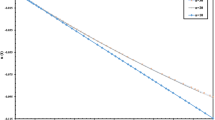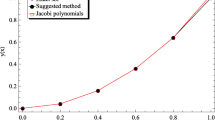Abstract
This paper is devoted to seeking the representation of solutions to a linear fractional delay differential equation of Hadamard type. By introducing the Mittag-Leffler delay matrix functions with logarithmic functions and analyzing their properties, we derive the representation of solutions via the constant variation method.
Similar content being viewed by others
1 Introduction
In the recent decades, fractional differential equations have been applied in engineering, physics, finance, and signal analysis. The researchers focused on the investigation of the existence, asymptotic stability, and finite-time stability of solutions of fractional linear and non-linear differential equations of Caputo type, Riemann–Liouville type, and Hadamard type [1,2,3,4,5,6,7,8,9,10,11].
Recently, the representation of solutions to delay differential equations has been considered. Klusainov and Shukin [12], Diblik and Klusainov [13, 14] derived the exact expressions of solutions of linear time invariant continuous and discrete delay equations by proposing the concepts of delay matrix functions. Next, stability and controllability problems of linear delay differential equations were studied extensively in [15,16,17]. For the literature on the related topic of linear fractional delay equations of Caputo and Riemann–Liouville type, we refer the reader to [18,19,20,21,22,23,24,25]. However, we find that there exists very limited work on the representation of solutions of fractional order delay differential equations of Hadamard type, even for linear case.
Motivated by the above-mentioned works, we try to introduce a new concept on fractional delay matrix function with a logarithmic function and use it to study the following linear fractional delay differential equations of Hadamard type:
where \({}_{H}\mathbb{D}_{1^{+}}^{\alpha }y\) denotes the α order Hadamard derivative, \({}_{H}\mathbb{I}_{1^{+}}^{1-\alpha }y\) denotes \(1-\alpha \) order Hadamard fractional integral, \(\alpha \in (0,1)\). \(T=k^{\ast }\tau \), \(k^{\ast }\in N^{+}=\{1,2,\ldots \}\), τ is a fixed moment. \(\varphi (\cdot )\) is an arbitrary Hadamard differentiable function, i.e., \({}_{H}\mathbb{D}_{1^{+}}^{\alpha } \varphi \) exists.
We use the idea from [19] and introduce a fractional delay matrix function with a logarithmic function that is used to seek a representation of solution of (1) by utilizing the constant variation method.
2 Preliminaries
Let \(a,b\in R\), \(a< b\), and \(C((a,b],R^{n})\) denotes a Banach space composed of continuous vector-valued functions. Θ denotes zero matrix, I denotes the standard identity matrix.
Definition 2.1
(see [1])
For a function \(y:(a,b)\rightarrow R^{n}\), the α order Hadamard integral of y is defined by
Definition 2.2
(see [1])
For a function \(y:(a,b)\rightarrow R^{n}\), the α order Hadamard derivative of y is defined by
Now we propose a new concept of fractional delay matrix function with logarithmic function.
Definition 2.3
Let \(\alpha \in (0,1)\). Fractional delay matrix function \(\mathbb{E} _{\tau ,\alpha }^{B(\ln x)^{\alpha }}\) with logarithmic function is defined by
Lemma 2.4
For \(k\tau < x\leq (k+1)\tau \), \(k\in N^{+}\), one has
where \(\mathbb{B}[\xi ,\eta ]=\int _{0}^{1}s^{\xi -1}(1-s)^{\eta -1}\,ds\) is a beta function.
Proof
Using the formula of integration by parts, we can obtain
The proof is completed. □
3 Representation of the solutions
In the section, we adopt the general method of solving linear fractional differential equations to seek the exact solutions by using the notation of \(\mathbb{E}_{\tau ,\alpha }^{B(\ln \cdot )^{\alpha }}\).
We establish the following fundamental result.
Theorem 3.1
If \(\mathbb{E}_{\tau ,\alpha }^{B(\ln \cdot )^{\alpha }}:(k\tau ,(k+1) \tau ]\longrightarrow R^{n\times n}\), \(k\in N^{+}\) satisfies
then \(\mathbb{E}_{\tau ,\alpha }^{B(\ln x)^{\alpha }}\) is a solution of \(({}_{H}\mathbb{D}_{1^{+}}^{\alpha }y)(x)=By(x-\tau )\) with the initial value \(\mathbb{E}_{\tau ,\alpha }^{B(\ln x)^{\alpha }}=I\frac{( \ln x)^{\alpha -1}}{\varGamma (\alpha )}\), \(1< x\leq \tau \).
Proof
If \(x\in (-\infty ,1]\), according to Definition 2.3, we have \(\mathbb{E}_{\tau ,\alpha }^{B(\ln x)^{\alpha }}=\varTheta \), obviously, (2) holds. Next, for \(x\in (k\tau ,(k+1)\tau ]\), \(k\in N^{+}\), we use mathematical induction to prove that the conclusion is also valid.
(i) When \(k=1\), \(\tau < x\leq 2\tau \), we have
According to (3) and Lemma 2.4, we can get
(ii) When \(k=2\), \(2\tau < x\leq 3\tau \), we have
According to (4) and Lemma 2.4, we can get
(iii) Assume \(k=n\), \(n\tau < x\leq (n+1)\tau \), the following equality holds:
For \(k=n+1\), \((n+1)\tau < x\leq (n+2)\tau \), we can get
According to (5) and Lemma 2.4, we can get
Then, for \(\forall k\in N^{+}\), \(k\tau < x\leq (k+1)\tau \),
The proof is completed. □
In what follows, we give the main result of this paper.
Theorem 3.2
For \(k\tau < x\leq (k+1)\tau \), \(k\in N^{+}\), the solution \(y\in C(X,R ^{n})\) of (1) can be written to
where \(X=(k\tau ,(k+1)\tau ]\cap (1,(k+1)\tau ]\), \(0<\alpha < \frac{1}{n+1}\) or \(X=[k\tau ,(k+1)\tau ]\cap [1,(k+1)\tau ]\), \(\alpha \geq \frac{1}{n+1}\).
Proof
Assume that \(Y_{0}(x)=B\mathbb{E}_{\tau ,\alpha }^{B(\ln x)^{\alpha }}\) satisfies Theorem 3.1, and the solution of (1) is given by
where \(C\in R^{n}\) is an unknown constant vector, \(z(\cdot )\) is an unknown Hadamard differentiable function. Since \(Y_{0}(x)\) is the solution of Equation (1) and \(\mathbb{E}_{\tau ,\alpha }^{B( \ln x)^{\alpha }}=I\frac{(\ln x)^{\alpha -1}}{\varGamma (\alpha )}\), \(1< x \leq \tau \), thus we can choose C such that \(({}_{H}\mathbb{I} _{1^{+}}^{1-\alpha }y)(1^{+})=b\).
Let \(x\rightarrow 1^{+}\), by Definition 2.3, we have \(\mathbb{E}_{\tau ,\alpha }^{B(-\ln \tau -\ln s)^{\alpha }}=\varTheta \), \(1< s\leq \tau \). For \(1< x\leq \tau \), we obtain
It indicates that (7) has the form
By Definition 2.3, we divide \((0,\tau ]\) into two subintervals, we can get:
(i) For \(1< s\leq x\) and \(0\leq \ln x-\ln s\leq \ln x\), we have
(ii) For \(x< s\leq \tau \) and \(\ln x-\ln \tau \leq \ln x-\ln s\leq 0\), then \(\mathbb{E}_{\tau ,\alpha }^{B(-\ln \tau -\ln s)^{\alpha }}= \varTheta \). Thus, for \(1< x\leq \tau \), we have
By calculating Hadamard type fractional order derivatives on both sides of (8), we can get
The proof is completed. □
To end this paper, we give an example to illustrate the above theoretical result.
Let \(\alpha =0.3\), \(\tau =1.2\), \(k^{*}=4\). Consider
where \(y(x)=(y_{1}(x),y_{2}(x))^{T}\), \(b=(1,2)^{T}\), and
By Theorem 3.2, for every \(x\in (1.2k,1.2(k+1)]\), \(k=\{0,1,2,3,4 \}\), the solution of (9) can be represented by
where
References
Kilbas, A.A., Srivastava, H.M., Trujillo, J.J.: Theory and Applications of Fractional Differential Equations. Elsevier, Amsterdam (2006)
Zhu, B., Liu, L., Wu, Y.: Local and global existence of mild solutions for a class of nonlinear fractional reaction–diffusion equation with delay. Appl. Math. Lett. 61, 73–79 (2016)
Wang, Y., Liu, L., Wu, Y.: Positive solutions for a nonlocal fractional differential equation. Nonlinear Anal. 74, 3599–3605 (2011)
Zhang, X., Liu, L., Wu, Y.: Existence results for multiple positive solutions of nonlinear higher order perturbed fractional differential equations with derivatives. Appl. Math. Comput. 219, 1420–1433 (2012)
Wang, Y., Liu, L., Zhang, X., Wu, Y.: Positive solutions of a fractional semipositone differential system arising from the study of HIV infection models. Appl. Math. Comput. 258, 312–324 (2015)
Zhang, X., Liu, L., Wu, Y.: Variational structure and multiple solutions for a fractional advection–dispersion equation. Comput. Math. Appl. 68, 1794–1805 (2014)
Zhang, X., Mao, C., Liu, L., Wu, Y.: Exact iterative solution for an abstract fractional dynamic system model for bioprocess. Qual. Theory Dyn. Syst. 16, 205–222 (2017)
Zhang, X., Liu, L., Wu, Y., Wiwatanapataphee, B.: Nontrivial solutions for a fractional advection dispersion equation in anomalous diffusion. Appl. Math. Lett. 66, 1–8 (2017)
Jiang, J., Liu, L., Wu, Y.: Multiple positive solutions of singular fractional differential system involving Stieltjes integral conditions. Electron. J. Qual. Theory Differ. Equ. 2012, 43 (2012)
Klimek, M.: Sequential fractional differential equations with Hadamard derivative. Commun. Nonlinear Sci. Numer. Simul. 16, 4689–4697 (2011)
Ma, Q., Wang, R., Wang, J., Ma, Y.: Qualitative analysis for solutions of a certain more generalized two-dimensional fractional differential system with Hadamard derivative. Appl. Math. Comput. 257, 436–445 (2014)
Khusainov, D.Y., Shuklin, G.V.: Linear autonomous time-delay system with permutation matrices solving. Stud. Univ. Žilina Math. Ser. 17, 101–108 (2003)
Diblík, J., Khusainov, D.Y.: Representation of solutions of discrete delayed system \(x(k+1)=Ax(k)+Bx(k-m)+f(k)\) with commutative matrices. J. Math. Anal. Appl. 318, 63–76 (2006)
Diblík, J., Khusainov, D.Y.: Representation of solutions of linear discrete systems with constant coefficients and pure delay. Adv. Differ. Equ. 2006, Article ID 80825 (2006)
Khusainov, D.Y., Diblík, J., Růžičková, M., Lukáčová, J.: Representation of a solution of the Cauchy problem for an oscillating system with pure delay. Nonlinear Oscil. 11, 261–270 (2008)
Diblík, J., Fečkan, M., Pospišil, M.: Representation of a solution of the Cauchy problem for an oscillating system with two delays and permutable matrices. Ukr. Math. J. 65, 58–69 (2013)
Medveď, M., Pospišil, M.: Sufficient conditions for the asymptotic stability of nonlinear multidelay differential equations with linear parts defined by pairwise permutable matrices. Nonlinear Anal. 75, 3348–3363 (2012)
Li, M., Wang, J.: Exploring delayed Mittag-Leffler type matrix functions to study finite time stability of fractional delay differential equations. Appl. Math. Comput. 324, 254–265 (2018)
Li, M., Wang, J.: Finite time stability of fractional delay differential equations. Appl. Math. Lett. 64, 170–176 (2017)
Liang, C., Wang, J., O’Regan, D.: Representation of solution of a fractional linear system with pure delay. Appl. Math. Lett. 77, 72–78 (2018)
Cao, X., Wang, J.: Finite-time stability of a class of oscillating systems with two delays. Math. Methods Appl. Sci. 41, 4943–4954 (2018)
Mahmudov, N.I.: Delayed perturbation of Mittag-Leffler functions and their applications to fractional linear delay differential equations. Math. Methods Appl. Sci., 1–9 (2018). https://doi.org/10.1002/mma.5446
Mahmudov, N.I.: Representation of solutions of discrete linear delay systems with non permutable matrices. Appl. Math. Lett. 85, 8–14 (2018)
Mahmudov, N.I.: A novel fractional delayed matrix cosine and sine. Appl. Math. Lett. 92, 41–48 (2019)
Li, M., Debbouche, A., Wang, J.: Relative controllability in fractional differential equations with pure delay. Math. Methods Appl. Sci. 41, 8906–8914 (2018)
Acknowledgements
The authors acknowledge the support by the National Natural Science Foundation of China (11661016; 11271309).
Funding
This work is partially supported by the National Natural Science Foundation of China (11661016; 11271309).
Author information
Authors and Affiliations
Contributions
All authors read and approved the final manuscript.
Corresponding author
Ethics declarations
Competing interests
The authors declare that they have no competing interests.
Additional information
Publisher’s Note
Springer Nature remains neutral with regard to jurisdictional claims in published maps and institutional affiliations.
Rights and permissions
Open Access This article is distributed under the terms of the Creative Commons Attribution 4.0 International License (http://creativecommons.org/licenses/by/4.0/), which permits unrestricted use, distribution, and reproduction in any medium, provided you give appropriate credit to the original author(s) and the source, provide a link to the Creative Commons license, and indicate if changes were made.
About this article
Cite this article
Yang, P., Wang, J. & Zhou, Y. Representation of solution for a linear fractional delay differential equation of Hadamard type. Adv Differ Equ 2019, 300 (2019). https://doi.org/10.1186/s13662-019-2246-6
Received:
Accepted:
Published:
DOI: https://doi.org/10.1186/s13662-019-2246-6




